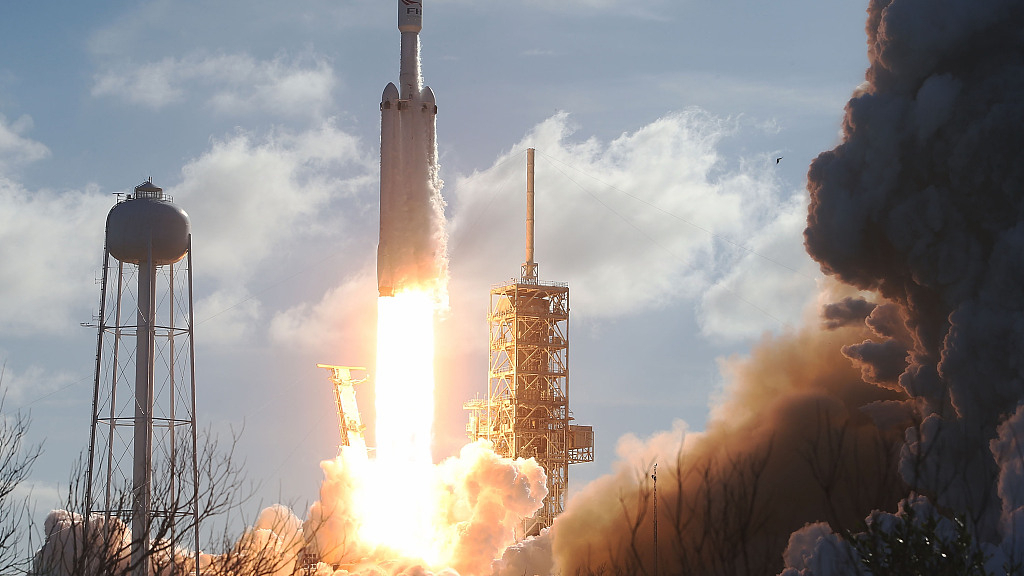
Editor's Note: Kang Jie is an assistant research fellow at the China Institute of International Studies. The article reflects the author's opinions, and not necessarily the views of CGTN.
The National Defense Authorization Act for Fiscal Year 2020, which was just signed by U.S. President Trump, has closed the two-year controversy over the creation of the Space Force. According to the act, the Space Force, as the sixth armed service, will be established under the Department of the Air Force and take over the Air Force's space military assets and combat missions.
Someone will oversee the R&D, testing, and acquisition of the Space Force. The act also creates a Chief of Space Operations (CSO) for the U.S. Space Force who will report directly to the Secretary of the Air Force and become a member of the Joint Chiefs of Staff. The status of the Space Force in the Pentagon is just the same as that of the Marine Corps.
Although the militarization of space or the space warfare still remain in sci-fi movies, military assets in space have become indispensable critical infrastructures for the military of all major countries. The satellites have played important roles in communication, navigation, guidance, and reconnaissance functions.
Sub-orbital hypersonic vehicles, Laser weapons, and anti-satellite weapons are also emerging, which will shift the military competition and even the strategic paradigm in the future.
Space forces are not something new. As early as the 1980s, the three major services of the U.S. armed forces established their own Space Commands, and in 1993, the Joint Space Command was established. In 1998, the Air Force published the first version of space doctrine and established a specialized space personnel training center. In 2002, the U.S. military integrated Joint Space Command into the Strategic Command.
At present, the U.S. space military assets are operated by the Army, Navy, Air Forces, and the National Reconnaissance Office and the National Geospatial Intelligence Agency. Among them, most of the space military assets are owned by the Air Force Space Command, with unparalleled budget share.
So, why did the U.S. decide to build a separate space service? The main reason comes from the different views on the military and strategic meaning of space.
Unlike the United States, which split the Air Force into two and created a new space service, Russia combined the Air Force and the Space Defense Force into the Aerospace Force, and China integrated the space, cyber and electronic warfare branches into the Strategic Support Force. These differences originated from the different offensive and defensive postures.
For example, Russia believes that any future war will start from space and air, and that the space inside and outside the atmosphere has increasingly become an interconnected unified battlefield. China and Russia hope to unify capabilities in different domains under the same command system in order to respond threats more effectively. In other words, China and Russia's space forces can be regarded as enhanced versions of "watch towers" and "shields."

U.S. President Donald Trump signing Space Policy Directive 4 to establish the Space Force in the Oval Office of the White House in Washington DC, U.S., February 19, 2019. /VCG Photo
U.S. President Donald Trump signing Space Policy Directive 4 to establish the Space Force in the Oval Office of the White House in Washington DC, U.S., February 19, 2019. /VCG Photo
For the United States, space is not only a place wholly distinct from the atmosphere, but also a war fighting domain, in which global situational awareness –"Prompt Global Strike" and global deterrence are the main missions of the Space Force. Space control, just like the command of the sea and the air superiority, means it intends to wipe out the enemy's presence in space and deprive the enemy's use and access to space.
Therefore, American space capabilities, like the "telescope" and "spear," are naturally offensive, and the Space Force needs not only the operational autonomy independent of other services, but also an independent personnel and budget power.
The other reason is about the budget efficiency and bureaucratic competition. Although the Trump administration and Congress have reached the consensus on increasing defense budgets, increase in military spending alone is not sufficient. Defense reforms must be used to increase the efficiency of military spending.
Since the Cold War, the Air Force has occupied the lion's share of the U.S. defense budget. Under the current overall budget environment, the U.S. Air Force is inclined to preserve its core tasks, namely, competing for air superiority and launching strategic strikes. Space is not its core area of focus.
Currently, the U.S. Air Force focuses on the procurement and development of next-generation main battle weapon systems, especially F-35 stealth fighter jets and B-21 bombers. Although space missions are important, they are expensive, so the Air Force has to reduce space mission expenses.
As a result, despite the Air Force's denial of reducing space spending, the White House and Congress are still concerned that competition between bureaucracies could cost the United States an opportunity to compete with China and Russia for a new space frontier.
From this perspective, the Space Force reforms of the past two years are also aimed at curbing the increasingly serious separation in the U.S. military.
(If you want to contribute and have specific expertise, please contact us at opinions@cgtn.com.)